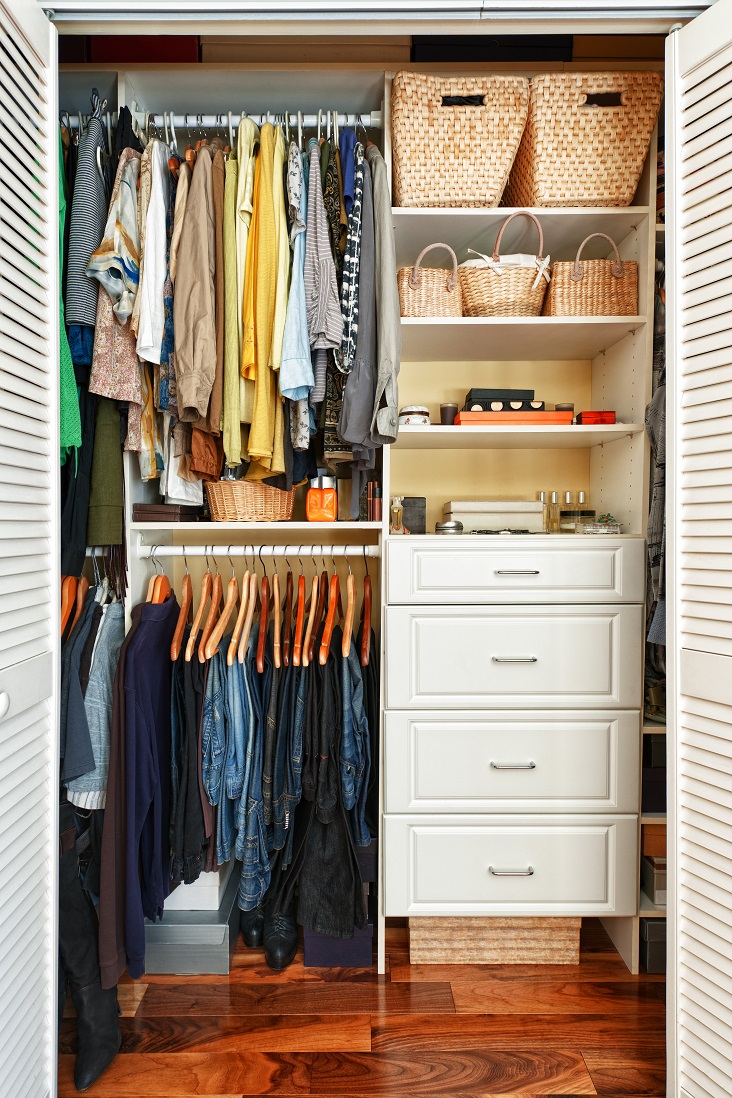losets are magical places. Think about it. When you store an item and come back a few days later, the item is still there.
If you think I sound sarcastic, it’s because closets really are mythical places…in that, they don’t exist. See, I live in a tiny New York apartment, where a closet is about as real to me as unicorns and calorie-free chocolate.
So where do I, and other unlucky urbanites like me, store my clothes, my shoes, and my dreams of square footage? I spoke with designers who shared their expertise. They admit that fitting your wardrobe into a small one-bedroom, or even a studio, is a challenge. But it can be done in a way that is both attractive and efficient.
Here are their tips:
If you do have a closet, maximize the space
Some of you lucky ducks have closets, albeit ones that can’t store all of your pretties. Marty Basher, a home organization expert at Modular Closets suggests that you double down on the closet space you do have, and “use what you have efficiently as possible.”
Many closets come with a single hanging rod and perhaps a shelf. But here’s how to up your closet game: Basher says, “Take one closet with a hanging rod and shelf [and] divide the closet in half with a panel. On one side of the panel, divide it with two hanging rods and on the other side, floor to ceiling shelving. Voilà. Almost doubled.”
Don’t feel like doing it yourself? “You can find many modular closet systems that can help make this trick easy,” says Basher.
Use a decorative screen
Decorative screens have been used as room dividers, to create a partition between a room’s different functions (say, visually separating the living room and the home office) or even to create a sense of privacy. And let’s not forget: They’re great for tucking items away.
Basher says, “You can utilize screens to make a pseudo closet. A small garment rack and portable shelving behind a full-size screen that matches your décor is a way to create storage in plain sight.”
With a plethora of attractive options http://www.roomdividers.com/, decorative screens may not give you extra storage, but it does keep your storage overflow from looking as if it’s flowing over.
Look underfoot
Kayla Hein, an interior architect with GH2 Architecture and the creative director at Modern Castle, says, “Instead of taking up precious space in your room with a bulky dresser or hanging rack, consider storing clothes under existing furniture. Under beds or sofas, there is prime real estate that can be used for storing narrow bins, full of out-of-season clothes.”
Furniture retailers, such as Ikea or Pottery Barn, will sell you a storage bed for a fee. But if your budget doesn’t stretch that far, get yourself an elevated bed frame. Place your belongings in a box or bin, and slide them out when needed.
Create a capsule wardrobe
If you don’t know what a capsule wardrobe is, you haven’t been keeping up with blogs on minimalism. Essentially, a capsule wardrobe is a limited wardrobe—30 or so staples—that you can mix and match. For some, it’s a radical approach to dressing; for others, it frees them from the grind and expense of shopping.
Hein says, “Capsule wardrobes are very small, so they can fit in the equivalent of a front closet, but the versatility is nearly endless.”
Capsule wardrobes force you to part with clothes you don’t frequently wear. But when you’re finished paring down your wardrobe, you’re left with clothes you love. Hein suggests, “Look for neutrals and pieces that easily mix and match. Fill in your capsule with a couple high-quality pieces and you’re good to go. ”
Repurpose your furniture
Ana Cummings, CEO of ANA Interiors and the design expert on CTV’s Homes and Lifestyles Canada, says, your furniture has to work for its living. “Every piece in the space also has to do double duty. An entry console will have drawers, [and] a cocktail table will also transform into a dining table.”
You can let your guests believe these drawers and tables hold only your teacups and family silverware handed down from the generations. But you and your besties know that they’re actually hiding your jammies.
As for me, I’ve rolled my t-shirts and put them in a nice basket…which I now have placed on my bookshelf. Insta-storage!
Pro tip: Don’t forget to store extras in your oven. With your home city on your doorstep, you know you weren’t using it anyway.
Flaunt your clothes out in the open
Why hide your clothing in a closet or under a bed when you can display your good taste and fashion sense for the world to see? Companies like Decorelo make clothes racks that are meant to integrate into your alcove. It’s Barenaked storage, and we’re okay with it.
Make sure to use matching hangers for a consistent look. We prefer these ones from Real Simple. They have a slim profile, are non-slip, and have styles for shirts or suits. You can even buy clips, which turns your shirt hanger into a skirt hanger.
If all else fails, rent a storage space
Storage spaces can frequently be inconvenient (some storage spaces are only accessible during business hours), not to mention expensive; with a rolling monthly fee, they’re the equivalent of paying up to $200 a month (egads) extra in rent.
But if you genuinely have no place to hang your snowboard and your ski pants, a storage space will give you and your apartment much-needed leg room.
If you happen to be one of those lucky folk with a closet, there are several ways you can repurpose the space to fit your specific needs, too.

